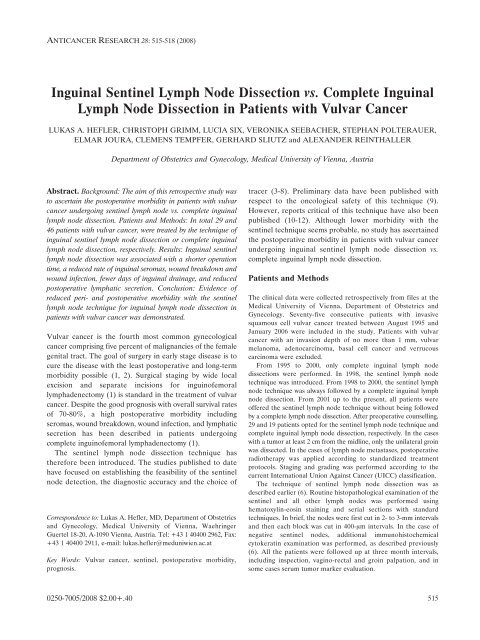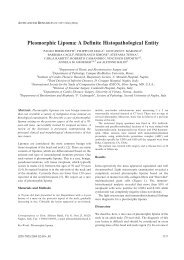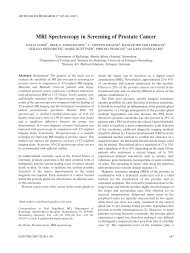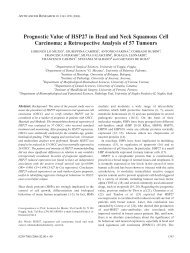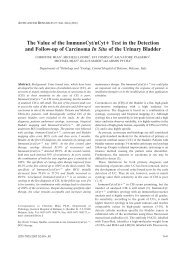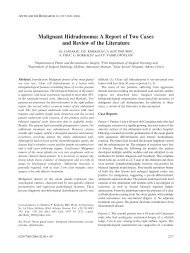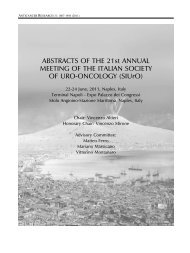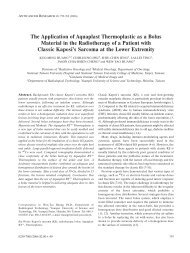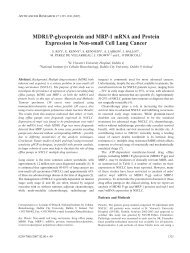Inguinal Sentinel Lymph Node Dissection vs. Complete Inguinal ...
Inguinal Sentinel Lymph Node Dissection vs. Complete Inguinal ...
Inguinal Sentinel Lymph Node Dissection vs. Complete Inguinal ...
Create successful ePaper yourself
Turn your PDF publications into a flip-book with our unique Google optimized e-Paper software.
ANTICANCER RESEARCH 28: 515-518 (2008)<br />
<strong>Inguinal</strong> <strong>Sentinel</strong> <strong>Lymph</strong> <strong>Node</strong> <strong>Dissection</strong> <strong>vs</strong>. <strong>Complete</strong> <strong>Inguinal</strong><br />
<strong>Lymph</strong> <strong>Node</strong> <strong>Dissection</strong> in Patients with Vulvar Cancer<br />
LUKAS A. HEFLER, CHRISTOPH GRIMM, LUCIA SIX, VERONIKA SEEBACHER, STEPHAN POLTERAUER,<br />
ELMAR JOURA, CLEMENS TEMPFER, GERHARD SLIUTZ and ALEXANDER REINTHALLER<br />
Abstract. Background: The aim of this retrospective study was<br />
to ascertain the postoperative morbidity in patients with vulvar<br />
cancer undergoing sentinel lymph node <strong>vs</strong>. complete inguinal<br />
lymph node dissection. Patients and Methods: In total 29 and<br />
46 patients with vulvar cancer, were treated by the technique of<br />
inguinal sentinel lymph node dissection or complete inguinal<br />
lymph node dissection, respectively. Results: <strong>Inguinal</strong> sentinel<br />
lymph node dissection was associated with a shorter operation<br />
time, a reduced rate of inguinal seromas, wound breakdown and<br />
wound infection, fewer days of inguinal drainage, and reduced<br />
postoperative lymphatic secretion. Conclusion: Evidence of<br />
reduced peri- and postoperative morbidity with the sentinel<br />
lymph node technique for inguinal lymph node dissection in<br />
patients with vulvar cancer was demonstrated.<br />
Vulvar cancer is the fourth most common gynecological<br />
cancer comprising five percent of malignancies of the female<br />
genital tract. The goal of surgery in early stage disease is to<br />
cure the disease with the least postoperative and long-term<br />
morbidity possible (1, 2). Surgical staging by wide local<br />
excision and separate incisions for inguinofemoral<br />
lymphadenectomy (1) is standard in the treatment of vulvar<br />
cancer. Despite the good prognosis with overall survival rates<br />
of 70-80%, a high postoperative morbidity including<br />
seromas, wound breakdown, wound infection, and lymphatic<br />
secretion has been described in patients undergoing<br />
complete inguinofemoral lymphadenectomy (1).<br />
The sentinel lymph node dissection technique has<br />
therefore been introduced. The studies published to date<br />
have focused on establishing the feasibility of the sentinel<br />
node detection, the diagnostic accuracy and the choice of<br />
Correspondence to: Lukas A. Hefler, MD, Department of Obstetrics<br />
and Gynecology, Medical University of Vienna, Waehringer<br />
Guertel 18-20, A-1090 Vienna, Austria. Tel: +43 1 40400 2962, Fax:<br />
+43 1 40400 2911, e-mail: lukas.hefler@meduniwien.ac.at<br />
Key Words: Vulvar cancer, sentinel, postoperative morbidity,<br />
prognosis.<br />
0250-7005/2008 $2.00+.40<br />
Department of Obstetrics and Gynecology, Medical University of Vienna, Austria<br />
tracer (3-8). Preliminary data have been published with<br />
respect to the oncological safety of this technique (9).<br />
However, reports critical of this technique have also been<br />
published (10-12). Although lower morbidity with the<br />
sentinel technique seems probable, no study has ascertained<br />
the postoperative morbidity in patients with vulvar cancer<br />
undergoing inguinal sentinel lymph node dissection <strong>vs</strong>.<br />
complete inguinal lymph node dissection.<br />
Patients and Methods<br />
The clinical data were collected retrospectively from files at the<br />
Medical University of Vienna, Department of Obstetrics and<br />
Gynecology. Seventy-five consecutive patients with invasive<br />
squamous cell vulvar cancer treated between August 1995 and<br />
January 2006 were included in the study. Patients with vulvar<br />
cancer with an invasion depth of no more than 1 mm, vulvar<br />
melanoma, adenocarcinoma, basal cell cancer and verrucous<br />
carcinoma were excluded.<br />
From 1995 to 2000, only complete inguinal lymph node<br />
dissections were performed. In 1998, the sentinel lymph node<br />
technique was introduced. From 1998 to 2000, the sentinel lymph<br />
node technique was always followed by a complete inguinal lymph<br />
node dissection. From 2001 up to the present, all patients were<br />
offered the sentinel lymph node technique without being followed<br />
by a complete lymph node dissection. After preoperative counselling,<br />
29 and 19 patients opted for the sentinel lymph node technique and<br />
complete inguinal lymph node dissection, respectively. In the cases<br />
with a tumor at least 2 cm from the midline, only the unilateral groin<br />
was dissected. In the cases of lymph node metastases, postoperative<br />
radiotherapy was applied according to standardized treatment<br />
protocols. Staging and grading was performed according to the<br />
current International Union Against Cancer (UICC) classification.<br />
The technique of sentinel lymph node dissection was as<br />
described earlier (6). Routine histopathological examination of the<br />
sentinel and all other lymph nodes was performed using<br />
hematoxylin-eosin staining and serial sections with standard<br />
techniques. In brief, the nodes were first cut in 2- to 3-mm intervals<br />
and then each block was cut in 400-Ìm intervals. In the case of<br />
negative sentinel nodes, additional immunohistochemical<br />
cytokeratin examination was performed, as described previously<br />
(6). All the patients were followed up at three month intervals,<br />
including inspection, vagino-rectal and groin palpation, and in<br />
some cases serum tumor marker evaluation.<br />
515
516<br />
ANTICANCER RESEARCH 28: 515-518 (2008)<br />
Table I. Clinical and outcome parameters in patients with vulvar cancer treated by inguinal sentinel lymph node dissection <strong>vs</strong>. complete inguinal lymph<br />
node dissection.<br />
<strong>Sentinel</strong> lymph <strong>Complete</strong> inguinal P-value<br />
node dissection lymph node dissection<br />
Number of patients 29 46<br />
Patients' age at surgery 67.7 (14.0) 64.1 (15.9) 0.4<br />
Tumor stage<br />
pT1 23 25 0.07<br />
pT2 6 19<br />
pT3 - 2<br />
<strong>Lymph</strong> node status 0.4<br />
pN0 21 31<br />
pN1 9 15<br />
Histological grade 0.4<br />
G1 7 18<br />
G2 19 24<br />
G3 3 4<br />
Unilateral lymphadenectomy 12 (41.3%) 6 (13%) 0.01<br />
Removed lymph nodes 4.4 (3.6) 11.8 (6)
The statistics were performed patient-wise and groin-wise<br />
depending on the outcome parameter. The comparisons between<br />
unpaired groups were made using Student's t-tests and Chi-square<br />
tests where appropriate. The survival probabilities were calculated<br />
by the product limit method of Kaplan and Meier. The differences<br />
between groups were tested using the log-rank test. The results<br />
were analysed for the end point of disease-free and overall survival.<br />
The survival times of patients disease-free or still alive were<br />
censored with the last follow-up date. Univariate and multivariate<br />
Cox regression models for disease-free and overall survival were<br />
performed. P-values of


